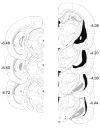Medial forebrain stimulation enhances intracranial nociception and attenuates morphine analgesia suggesting the existence of an endogenous opioid antagonist
- PMID: 20149816
- PMCID: PMC2859829
- DOI: 10.1016/j.pbb.2010.01.015
Medial forebrain stimulation enhances intracranial nociception and attenuates morphine analgesia suggesting the existence of an endogenous opioid antagonist
Abstract
The purpose of this experiment was to test in the rat the hypotheses that activation of the brain reward system would attenuate the effects of intracranial nociceptive stimulation and would potentiate the antinociceptive effects of morphine. In this experiment pain (nociception) was generated by electrical stimulation of a brain pain pathway, the mesencephalic reticular formation (MRF) of the rat. Reward pathway stimulation was to the medial forebrain bundle at the level of the lateral hypothalamus (MFB-LH). Current thresholds for escape from MRF stimulation were determined using a modification of the psychophysical methods of limits. MRF stimulation was delivered concurrently with different intensities of non-contingent MFB-LH stimulation. The effects of morphine and saline were determined under all stimulation conditions. Contrary to expectation MFB-LH stimulation significantly lowered MRF stimulation escape thresholds. Morphine administration elevated MRF thresholds in the absence of MFB-LH stimulation. However, this effect was blocked by concurrent MFB-LH stimulation. These findings, which mimic the effects of the opiate antagonist naloxone, i.e., potentiating of pain and antagonism of morphine's analgesic effects, suggest the presence of an endogenous opiate receptor antagonist.
Copyright 2010 Elsevier Inc. All rights reserved.
Figures



Similar articles
-
Mechanisms of morphine-venlafaxine interactions in diabetic neuropathic pain model.Pharmacol Rep. 2015 Feb;67(1):90-6. doi: 10.1016/j.pharep.2014.08.008. Epub 2014 Aug 21. Pharmacol Rep. 2015. PMID: 25560581
-
Low-dose apomorphine attenuates morphine-induced enhancement of brain stimulation reward.Pharmacol Biochem Behav. 1996 Sep;55(1):87-91. doi: 10.1016/0091-3057(96)00073-1. Pharmacol Biochem Behav. 1996. PMID: 8870042
-
Endogenous opioids are involved in morphine and dipyrone analgesic potentiation in the tail flick test in rats.Eur J Pharmacol. 2006 Sep 28;546(1-3):54-9. doi: 10.1016/j.ejphar.2006.07.027. Epub 2006 Jul 22. Eur J Pharmacol. 2006. PMID: 16914138
-
Nociceptive threshold and analgesic response to morphine in aged and young adult rats as determined by thermal radiation and intracerebral electrical stimulation.Pharmacol Biochem Behav. 2006 May;84(1):148-57. doi: 10.1016/j.pbb.2006.04.021. Epub 2006 Jun 8. Pharmacol Biochem Behav. 2006. PMID: 16759686
-
Antagonists of excitatory opioid receptor functions enhance morphine's analgesic potency and attenuate opioid tolerance/dependence liability.Pain. 2000 Feb;84(2-3):121-31. doi: 10.1016/s0304-3959(99)00223-7. Pain. 2000. PMID: 10666516 Review.
References
-
- Barone FC, Wayner MJ, Zarco de Coronado I, Tsai WH. Mesencephalic reticular formation stimulation effects on hypothalamic neuronal activity. Brain Res Bull. 1981;7:419–25. - PubMed
-
- Beitz AJ. Possible origin of glutamatergic projections to the midbrain periaqueductal gray and deep layer of the superior colliculus of the rat. Brain Res Bull. 1989;23:25–35. - PubMed
-
- Bodner R, Kelley DD, Brutus M, Glusman M. Stress induced analgesia: neural and hormonal determinants. Neurscience Biobehav Rev. 1980;4:87–100. - PubMed
-
- Carr KD, Coons EE. Rats self-administer nonrewarding brain stimulation to ameliorate aversion. Science 1982. 1982;215:1516–7. - PubMed
-
- Cox VC, Valenstein ES. Attenuation of aversive properties of peripheral shock by hypothalamic stimulation. Science . 1965;149:323–325. - PubMed
Publication types
MeSH terms
Substances
Grants and funding
LinkOut - more resources
Full Text Sources
Medical
Miscellaneous

